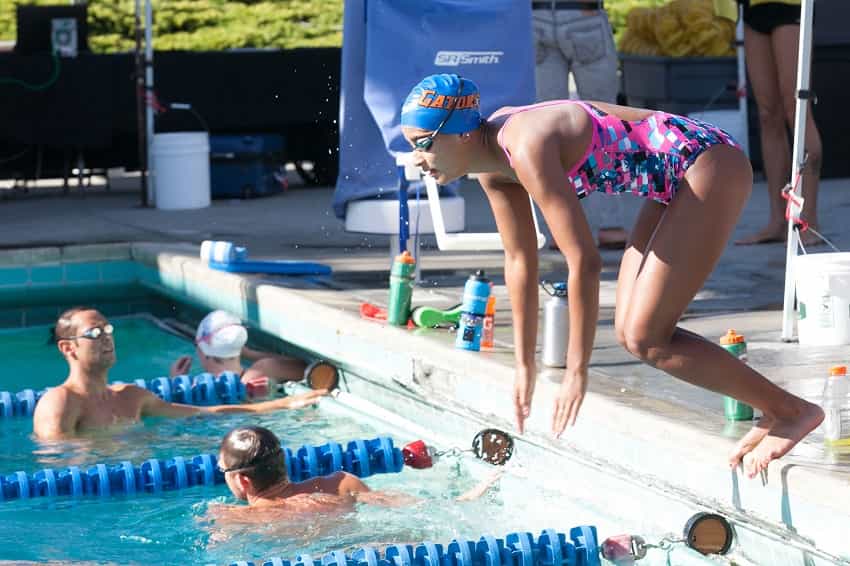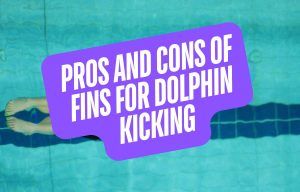Swimming for fitness and exercise is one of the best ways to get in shape, lose weight, and build muscle. Here is a breakdown of what you need to know to get started with swimming.
If you are intrigued by the idea of hopping into the water and swimming for exercise but don’t know where to start, this guide is for you.
We will cover some of the basics, including:
- Why swimming is pound-for-pound the best form of exercise out there
- The essential gear you need for swimming for exercise
- How to build a swim workout (including an example 60-minute swim practice)
- And some guidelines for making the most of your time in the water
Let’s dive right in.
Why Swimming is the Best Form of Exercise Out There
Full disclosure: I am fully and completely biased in saying that swimming is the best form of exercise there is.
I’ve been in and around swimming pools since I was 5 years old, and nearly 35 years later, my passion and love for the sport has only increased. My skin and hair have smelled like chlorine for the better part of four decades.
But there is a lot of research out there that supports my life-long infatuation with swimming for fitness and exercise.
Some of the health benefits of swimming for exercise include:
- Swimming decreases tension, stress, and leaves swimmers feeling “mentally refreshed.” [1]
- Swimming burns a metric ton of calories, with one study showing that 30-minutes of front crawl burned 488 calories, the same as running 9 minutes per mile.
- You can exercise longer. Because of its low impact nature, exercisers spend more time swimming versus other higher-impact forms of exercise
- Swimming builds muscle, too. Even though swimming is done in a largely weightless environment, you are still building muscles along with strong lungs [2] and an excellent aerobic system.
Gearing Up for the Pool
Swimming looks like a super simple sport when it comes to picking out the right equipment.
Pick out a pair of swim goggles and a swimsuit, and off we go!
But even something as simple in functionality like goggles and a swimsuit come in a nearly endless variety of options.
With swimsuits for lap swimming, there are drag suits, two-piece swimsuits, for the fellas—swim briefs, and even open water and triathlon wetsuits for cold water swimming.
Ultimately, you want a swimsuit that gives you a full range of motion, is at least mildly resistant to chlorine (look for suits high in polyester—they last longest), and is snug enough that it doesn’t create a ton of needless drag and resistance in the water.
Swim goggles are another essential for swimming for exercise. They help you see under the water so that you can keep an eye (or two) out for lane lines, other swimmers, and the wall.

Goggles protect your eyes from nasty chloramines which leave your eyes red and itchy. Chloramines are the yucky result of what happens when chlorine binds with sweat, pee and other “body waste” swimmers bring into the pool.
Swim goggles are generally cheap and long-lasting (look for goggles and head straps made of silicone—they are the most durable), and there are other options, including swimming masks, which give swimmers extra wide peripheral vision in the water.
Other options for protecting the eyes and enhancing underwater vision include swim goggles with nose covers, which are an excellent type of swim goggle for snorkeling and for people who struggle with getting water in their nose.
While swim caps aren’t required in the lap pool, they are a good idea as they keep hair out of your eyes, keep hair out of the pool, and protect your hair from chlorine.

The Versatility of Swimming for Exercise
One of the many perks of lap swimming is the versatility. The workout you get is ultimately only limited by your imagination.
Beginner swimmers may only be familiar with freestyle (front crawl), the stroke that you see performed most frequently at the pool. But there are three other strokes—butterfly, backstroke, breaststroke—with which you can mix things up with.
On top of that, you can design your swim workout to specifically target your upper body or lower body. Pull buoys target the upper body—shoulders, lats, arms, chest—and kickboards—one of the first swimming aids most of us come across—isolate the legs for an excellent lower body workout.
While most swimmers will jump into the water and swim unbroken freestyle for the duration of their workout, a way to increase the challenge and physical health benefits of swimming for exercise comes with doing some quick structuring of your workout.
Here is a simple way to chunk down your swim training.
Warming-up. Swim pools are often a little chilly. I’ve always found that getting warm and ready for my workout takes a little longer. Add some kicking to get the blood-flow really going. Hop in, start easy, and steadily build up to a slightly vigorous effort, giving all of your muscles—core, arms, back, legs, pulmonary—a chance to get warm.
Sample warm-up for a 60-minute swim practice:
4×100 freestyle (50 swim, 50 kick) @:30 rest between reps
The Pre-Set. The pre-set is mainly for technical proficiency. During this set, we are performing specific drill work to help improve our efficiency and technique in the water. Swimming faster isn’t just about effort—it’s about making yourself as efficient as possible in the water. The pre-set should include stroke-specific drill work and quick bursts of effort that set the stage for the main set.
Sample pre-set for a 60-minute swim practice:
6×50 as 25 freestyle drill choice, 25 swim build to 90% effort @:20 rest between reps
The Main Set. This is the meat and potatoes of your swim workout. Now that you are fully warmed up and your technique is on point, it’s time to get to work! If your goal is straight-aerobic conditioning, this is where you are doing the work. If your goal is speed and power, here’s where we do those high-intensity reps we tons of rest.
Sample main set for a 60-minute swim practice:
16×100 freestyle swim @2:00 (best average)
The Warm-Down. For swimmers on a time-crunch, it’s tempting to hop out after the last rep of the main set is over and hit the bricks. I know I’ve done this more than a few times. But taking a few minutes to unwind and warm-down speeds up recovery and ward off injury. I typically do counter-movement swimming during my warm-down to open up my chest and shoulders. For example, if I do a lot of swimming on my front doing freestyle, I will do a lot of backstroke during my warm-down.
Sample warm-down for a 60-minute swim practice:
6×50 double-arm backstroke @:25 rest between reps
If you have the time for a full workout, use each of these four sections to build a comprehensive session in the water that helps you swim with better technique, warm up properly, have enough time to crush a big main set, and some time to relax and unwind at the end.
Take Your Swimming to the Next Level
As you spend more time swimming for fitness and exercise, and you pick up more of the swimming terminology and progressively get into better shape, you will discover the nearly endless number of ways to get better in the water.
Here are some ideas for taking your swimming fitness to the next level.
- Set yourself some goals. Spending a specific amount of time in the water, or swimming a certain number of laps, or having a written set and workout is a great way to encourage accountability and keep you focused. Whether you are trying to get faster in the water with pool training or dryland workouts, goals give you clarity and purpose.
- Count your strokes. Balance getting fit with swimming efficiently, and one way to do this is by counting your strokes for each length. There are plenty of tools to help you do this, including the latest generation of swim watches and waterproof fitness trackers, but getting into the habit of counting your strokes and seeing how long you can maintain that stroke count is something you should learn.
- Crank up the intervals and distance. As you get fitter, the intervals and distances you used at the start will get easier. Decrease the rest and speed up the intervals as you get faster and fitter.
- Get technical feedback. Use a qualified swim coach, swim with a team, or take video of yourself to see how you can improve technically. There are plenty of masters swim teams out there offering all sorts of training, from competition to strictly fitness.
Like every form of exercise, swimming for fitness means putting together some simple goals for your time in the water, having a plan for your training, and swimming with focus and intent as you get closer to your goals.
More Stuff Like This
3 Swimming Workouts for Beginners. Looking for some beginner swim workouts that you can easily adjust according to your current fitness and skill level? Here are three of my favorites.














